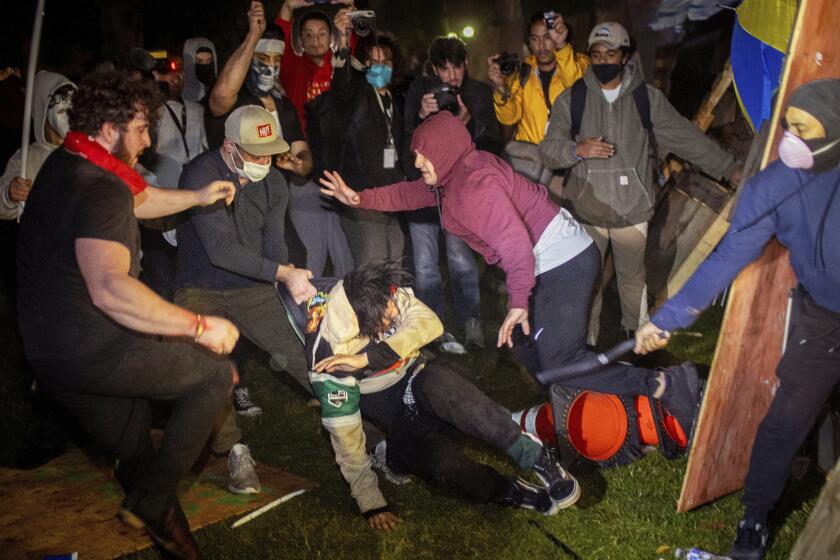UC Merced’s new course
The moon already cast a glow on the irrigation canals that cross the UC Merced campus. Despite the hour, about 80 students slipped into lecture hall seats for an engineering class that starts at 8:30 p.m. and goes until nearly 10.
Sophomore Kenneth Simpliciano said he wished the statistics and dynamics class were earlier in the day so he didn’t need energy drinks to get through it. Still, he’s glad that UC Merced is stretching the use of its facilities so he can get the courses he needs for his mechanical engineering major and can graduate in four years.
Night and early morning classes are becoming more common at UC’s youngest campus as it tries to balance the needs of a growing student body, now totaling 5,760, against state budget problems that have limited construction and hiring. Seven years since its opening, the school also is trying to develop a stronger and more magnetic identity.
UC Merced’s leaders say the school will never be a UCLA-style mega-university with a hefty course catalog. Campus leaders, in fact, have stopped talking for now about a campus of 25,000 students and instead are projecting enrollment at 10,000 by decade’s end if construction money can be found.
And to reduce costs, the school is at least temporarily scaling back plans to build dorms and classrooms across its vast 840 acres in the San Joaquin Valley, much of it cattle grazing fields with Sierra Nevada views. A more compact campus with taller buildings is likely.
“Frankly, the economic situation in the state of California is such that we can’t grow as fast as people once thought we could. If that’s the case, we have to think differently about how we develop this campus,” said Dorothy Leland, a philosophy professor who last year became UC Merced’s third chancellor.
UC Merced, compared with other UC schools, probably will be “a very focused, smaller and intimate University of California campus, and that will be a plus for us,” she said.
Students are torn about the future of the first new UC in four decades. Many want the perks of a big school, especially a football team, more social activities and wider course offerings. But others cherish the school’s cozy and somewhat isolated nature and boast that professors know their names and ask them to help with research.
Chelsea Coe, 22, transferred to UC Merced from Santa Monica College. “It was a huge culture shock,” she said. “Oh, my God, there are cows everywhere, but there is no Trader Joe’s or Whole Foods.”
But the cognitive science major said she soon got past all that and came to appreciate the opportunities. Still, she wants the campus to grow, not to 40,000 students like UCLA, but large enough so it is “not the environment where everybody knows everybody.”
The campus received nationwide notice when First Lady Michelle Obama spoke at the commencement of its first graduating class in May 2009. Enrollment is up sixfold since the pioneer class and 11% this fall over last year. Although the school was founded to bring more education to the Central Valley region, undergraduates hail from around the state, a third each from Southern California, the Central Valley-Sacramento area and Northern California.
Merced, however, still faces resistance among some potential applicants, and even the allure of outdoor programs at Yosemite National Park 90 minutes away can’t seduce them. Although applications increased this fall, Merced was still by far the least popular and competitive in the system. And it remains the only UC to guarantee qualified students a spot if all other schools reject them.
Initial graduation rates have been relatively low. Only about 35% of the university’s first class completed college there in four years, compared with 60% UC-wide, and 63% of the class graduated in six years, compared with the UC average of 82%.
Jane Lawrence, vice chancellor for student affairs, attributed that gap to students who transferred because Merced did not offer their preferred major. She said that was improving since offerings have expanded, now to 19 undergraduate majors.
Jonathan Ly, 21, a political science and economics major from Norwalk, at first thought he would transfer to a school like UC Irvine or Davis with more name cachet. But he became a student government activist at Merced and realized the advantages of attending a still-emerging school.
“At the more established UC campuses, you are following a legacy, but you can really make a difference at UC Merced because it is growing,” he said.
Samantha Ozeran, 18, a freshman biology major from Beverly Hills, said she came to Merced reluctantly, drawn by a merit scholarship that other UC campuses did not match.
She said she appreciates the high quality of her professors and the personal attention but misses the big football games and more vibrant weekend activities that she hears about at large schools. She said she probably would try to transfer and was willing to sacrifice Merced’s small class sizes for “more social life and school spirit and rah rah.”
After initial delays caused by environmental issues, the campus has a set of striking contemporary-style buildings, with shaded pedestrian arcades and giant screens for respite from the Valley sun. Three construction projects are underway: a five-story, 500-bed dormitory, a science building and a student services facility, mainly with funds generated before the recession or from bonds linked to fees.
The school recently scored a victory when Gov. Jerry Brown approved $4.7 million to design a large classroom building that had been rejected in previous years. Now Merced hopes for $50 million in construction funding next year, although that remains uncertain.
Meanwhile, UC Merced is stretching its physical assets. About 28% of all classes start either before 9 a.m. (some classes begin at 7:30) or after 6 p.m. To make more room, hundreds of office and technology support workers have been shifted to rented facilities off campus. The university is negotiating with a local school district to possibly lease underutilized science classrooms in a new high school.
Officials say they probably will suspend plans to spread far beyond the campus’ current 104-acre footprint. Leland says it is too costly to extend utilities to the additional 700 acres on which UC has environmental approval to build. So it’s likely that new dorms and classrooms will replace current parking lots, which will then move to grazing lands.
Campus architect Tom Lollini says the school isn’t abandoning its master plan for a city-like spread with 25,000 students. But given economic constraints, “it may take 50 years.”
The shift has frustrated professors who expected the rapid growth of UC campuses established in the 1960s, according to UC Merced faculty Senate Chairwoman Peggy O’Day.
“That model is just not the 21st century reality,” said O’Day, a geochemist. “We are finally realizing we have to be something different, and we have to think differently about how to make this campus successful.”
The school is gaining a strong reputation in such interdisciplinary fields as alternative energies, environmental sustainability, computer imaging, cognitive science and public policies that affect its region. “I think our identity is still coming into focus,” O’Day said. “I don’t think we’ve completely branded ourselves by any means.”
William Tierney, director of USC’s Pullias Center for Higher Education, said he hopes Merced will remain different from other UC campuses. He said it should emphasize teaching more than research and promote year-round studies and more online education to reduce construction: “This is an opportunity for UC Merced to redefine itself and not try to duplicate what other UCs do.”
Whatever happens, Philip Nguyen, 22, has seen effects of the school’s growth since he arrived as a freshman four years ago. “It was pretty empty then.”
Now, the management major from Oakland, who expects to graduate in December, said he must start out early enough to find a parking spot and a classroom seat. So he hopes the university gets the money to build more classrooms and other facilities, including a stadium, not just for current students but also to help boost UC Merced’s identity in the next generation.
“I hope UC Merced will have the prestige of having its name known not just locally,” he said. “Hopefully people out of state will know where UC Merced is.”
--
--
(BEGIN TEXT OF INFOBOX)
At a glance
UC Merced, fall 2012:
Enrollment: 5,431 undergraduate students and 329 graduate students
Ethnicity: 38% Latino, 27% Asian, 18% white and 6% black
Applications: 12,838, up 11% from last year
Student life: 85% of students said they are somewhat to very satisfied with academics; 82% with social life.
--
Source: UC Merced
More to Read
Start your day right
Sign up for Essential California for news, features and recommendations from the L.A. Times and beyond in your inbox six days a week.
You may occasionally receive promotional content from the Los Angeles Times.







